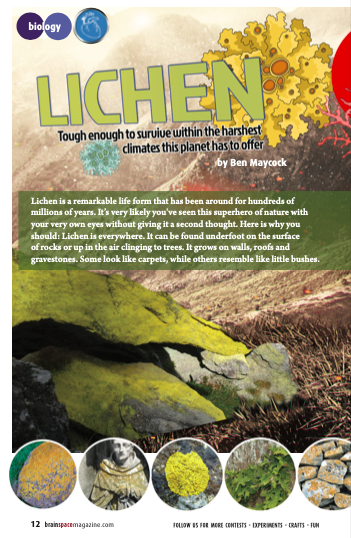
Tough enough to survive within the harshest climates this planet has to offer
Lichen is a remarkable life form that has been around for hundreds of millions of years. It’s very likely you’ve seen this superhero of nature with your very own eyes without giving it a second thought. Here is why you should: Lichen is everywhere. It can be found underfoot on the surface
of rocks or up in the air clinging to trees. It grows on walls, roofs and gravestones. Some look like carpets, while others resemble like little bushes.


This remarkable life form is actually the result of two very different organisms working together. A fungus provides a structure on which the species can live, and an alga provides food by turning moisture and sunlight into starches and sugars through photosynthesis. This symbiotic relationship works so well that neither one would survive in the environment without the help of the other.
Symbiosis
Symbiosis is the relationship between two or more organisms that live closely together, usually to each one’s benefit. Lichen survive in some of the planet’s most extreme environments, from the intense heat of the hottest deserts to the frozen North and South Poles. They can live atop the world’s highest mountains and also below the surface of the water.
DID YOU KNOW?
- There are about 200 different kinds of lichens in Antarctica.
- Lichen have been launched into space. As an experiment, the European Space Agency sealed two species of lichen into a Russian rocket. Once in orbit, the lichen was exposed to the vacuum of space, cosmic radiation and dramatic changes in temperature. After 15 days the lichen were retrieved and showed no sign of damage!
- Lichen are some of the earliest life forms on the planet. Its fossil record dates back at least 400 million years, and it is thought that earlier forms may have existed over 600 million years ago. A key to the lichen’s long existence may lay in the fact that it does not need a regular supply of water. If conditions do not favour a healthy life, the lichen can go into suspension or “shut down.” When conditions improve, the lichen revives itself.
- From the animals that feed upon it to those that use it for shelter, hundreds of species depend upon lichen. Reindeer feed exclusively on lichen in winter. Flying squirrels use it to make nests. Tiny insects live within it and feed upon it. Lichen even feed minerals to the soil when breaking down the rocks they live upon.
- This seemingly unstoppable force of nature has a weakness that threatens not only its life, but those that depend upon it: air pollution. Because lichen absorb nutrients directly from the air and the water that washes over them, they are extremely sensitive to the atmosphere. When air pollution is too great lichen cannot survive. This is why scientists believe the health of lichen is a very good indicator of the health of an environment.
